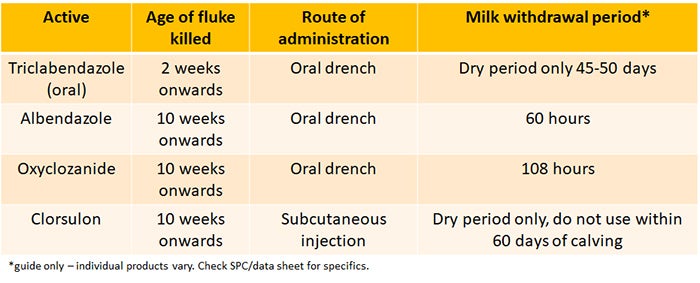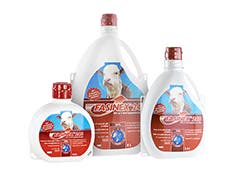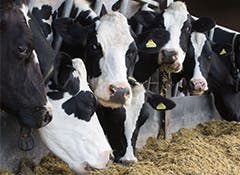Managing liver fluke in dairy cows
Effectively managing fluke infections in dairy cows is inherently difficult because of the limited number of actives available and the limited opportunities to treat cows without discarding milk.
What is the impact of liver fluke on dairy cows?
The impact of liver fluke on any animal is hugely variable depending entirely on the number of fluke ingested. However, studies have shown affected animals can suffer:
- a reduction in milk yield by 3.8%-15%1
- reduced butterfat and protein percentage2
- reduced feed conversion efficiency and dry matter intake3
- reduced fertility1
Unlike gastrointestinal worms cattle do not develop immunity to liver fluke, therefore any dairy animal grazing pastures with mud snail habitats from August onwards is potentially at risk of fluke infection. See COWS website for more information on when infectious stages of fluke are likely to be present.
Once liver fluke are in the liver they can survive there for months and in many cases years unless an effective treatment is given. Find out more about liver fluke.
Sustainable liver fluke control in dairy herds
Effective management of liver fluke in dairy cows is based on a ‘4 Point Plan’ that target the critical points in the fluke life cycle.
- Pasture protection: using an effective adulticide treatment in early summer to minimise pasture contamination with fluke eggs going into autumn.
- Pasture management: To minimise snail habitats and the snail population. For example, maintaining effective drainage, fixing leaky trough, minimising poached areas and ruts caused by vehicles.
- Grazing management: To avoid grazing areas of snail habitat once metacercariae start to appear on pasture. For example:
- electric fencing round wet or boggy areas;
- moving animals to lower risk grazing;
- housing to keep animals off high risk areas at high risk times of year;
- permanently excluding animals from the highest risk areas (environmental schemes)
- Effective treatment of animals at risk: Using the right active at the right time. This means being aware of the stages of fluke that are likely to be within the animal at the time of treatment and selecting an appropriate active to control that. Eg. At housing, cows are likely to have early immature and immature fluke so oral triclabendazole would be an appropriate choice.
We cannot rely solely on animal treatment, we need to consider all the 4 points above for sustainable control.
What can we treat with, and when?
Managing liver fluke takes thought and forward planning to minimise the impact of fluke on the dairy herd while ensuring compliance with milk withdrawal periods. Licensed treatment options for adult dairy cows include:

Where a lack of efficacy is suspected with any treatment, contact your vet and testing can be carried out to confirm this. If you have known triclabendazole resistance on farm, careful use of all the remaining actives will be necessary. Just switching to the next active on the list for the ability to kill immature fluke will lead to overuse of this active, and will then generate resistance to those actives too.
Testing for medicine residues
Eamon Watson BVSc MSc NDA MRCVS Veterinary Advisor at National Milk Laboratories, comments on testing for medicine residues:
“Testing for residues isn’t about catching people out, it’s about assuring the milk supply chain and testing is a central part of this. The testing for medicine residues, including flukicides, has taken a step forward. New technology means it’s now relatively simple to screen bulk milk samples for the range of worm, fluke and other endectocide products. National Milk Laboratories have been using this testing technology for some time to help milk buyers and vets investigate bulk tank fails from antibiotic residues in milk samples and are currently validating a new test for use to detect residues from injectable, pour-on and oral parasiticide products.
Testing for flukicides isn’t new – but testing for a broad range of medicines is now much easier. It is worth highlighting that awareness around medicine residues has always been a vital part of ensuring food products are of the highest quality. This all starts with the correct selection and use of products to minimise the risk of residues in milk from treated cows.”
- Schweizer, G., Braun, U., Deplazes, P., Torgerson, P.R., 2005. Estimating the financial losses due to bovine fasciolosis in Switzerland. Vet. Rec. 157,188–193
- Associations between fasciolosis and milk production, and the impact of anthelmintic treatment in dairy herds Kerstin Köstenberger, Alexander Tichy, Karl Bauer, Peter Pless, and Thomas Wittek Parasitol Res. 2017; 116(7): 1981–1987.
- Production Effects of Liver Fluke in Cattle I. the Effects of Infection on Liveweight Gain, Feed Intake and Food Conversion Efficiency in Beef Cattle Hope Cawdery, M.J.; Strickland, K.L.; Conway, A.; Crowe, P.J. Journal Title: British Veterinary Journal Publisher: W.B. Saunders Publication Date: 3/1977. Volume 133. Issue 2. Pages 145-159


